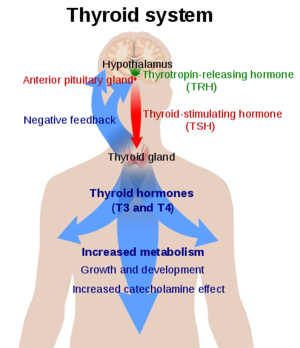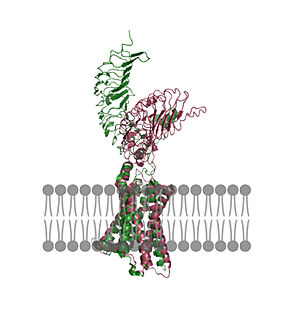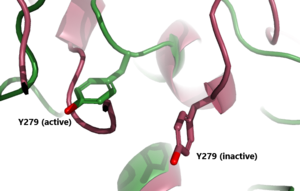Sandbox Reserved 1792
From Proteopedia
(Difference between revisions)
| Line 23: | Line 23: | ||
== Active vs Inactive State== | == Active vs Inactive State== | ||
| - | [[Image:Untitled (1).jpg|300 px|right|thumb| Figure 2: An overview of the Inactive (pink) vs Active (green) state of TSHR. PDB: 7t9m and 7t9i]] [[Image:Inactive v active residue.png|300 px|right|thumb| Figure 3: A zoomed in view of the Y279 residue in the Hinge Region of TSHR, showing the 6 angstrom move of Y279 during the activation of TSHR. Active TSHR is shown in green (PDB: 7t9i) and inactive TSHR is shown in pink (PDB: 7t9m).]] | + | [[Image:Untitled (1).jpg|300 px|right|thumb| Figure 2: An overview of the Inactive (pink) vs Active (green) state of TSHR embedded in the plasma membrane. PDB: 7t9m and 7t9i]] [[Image:Inactive v active residue.png|300 px|right|thumb| Figure 3: A zoomed in view of the Y279 residue in the Hinge Region of TSHR, showing the 6 angstrom move of Y279 during the activation of TSHR. Active TSHR is shown in green (PDB: 7t9i) and inactive TSHR is shown in pink (PDB: 7t9m).]] |
When TSHR is not bound to TSH, it is in the <scene name='95/952720/Inactivetshr/8'>inactive state</scene>. This is also considered the "down" state because the LRRD is pointing down. When TSH binds to TSHR, steric clashing between TSH and the cell-membrane cause TSHR to take on the <scene name='95/952720/Inactivetshr/6'>active or "up" state</scene> (fig 2). During this transition, the Extracellular domains rotate 55° along an axis. This rotation is caused by conformational changes within the <scene name='95/952720/Hinge_region_spin/1'>Hinge Region</scene>, specifically at the <scene name='95/952720/Hinge_region_residues/2'>Y279 residue</scene>. This residue moves 6 angstroms relative to I486, which is a residue located in the Transmembrane Region <ref name="Faust"/> (Fig 3). | When TSHR is not bound to TSH, it is in the <scene name='95/952720/Inactivetshr/8'>inactive state</scene>. This is also considered the "down" state because the LRRD is pointing down. When TSH binds to TSHR, steric clashing between TSH and the cell-membrane cause TSHR to take on the <scene name='95/952720/Inactivetshr/6'>active or "up" state</scene> (fig 2). During this transition, the Extracellular domains rotate 55° along an axis. This rotation is caused by conformational changes within the <scene name='95/952720/Hinge_region_spin/1'>Hinge Region</scene>, specifically at the <scene name='95/952720/Hinge_region_residues/2'>Y279 residue</scene>. This residue moves 6 angstroms relative to I486, which is a residue located in the Transmembrane Region <ref name="Faust"/> (Fig 3). | ||
== Specific Residues == | == Specific Residues == | ||
Revision as of 17:54, 20 April 2023
Thyroid Stimulating Hormone Receptor (TSHR)
| |||||||||||
References
- ↑ Hanson, R. M., Prilusky, J., Renjian, Z., Nakane, T. and Sussman, J. L. (2013), JSmol and the Next-Generation Web-Based Representation of 3D Molecular Structure as Applied to Proteopedia. Isr. J. Chem., 53:207-216. doi:http://dx.doi.org/10.1002/ijch.201300024
- ↑ Herraez A. Biomolecules in the computer: Jmol to the rescue. Biochem Mol Biol Educ. 2006 Jul;34(4):255-61. doi: 10.1002/bmb.2006.494034042644. PMID:21638687 doi:10.1002/bmb.2006.494034042644
- ↑ 3.0 3.1 3.2 3.3 3.4 Duan J, Xu P, Luan X, Ji Y, He X, Song N, Yuan Q, Jin Y, Cheng X, Jiang H, Zheng J, Zhang S, Jiang Y, Xu HE. Hormone- and antibody-mediated activation of the thyrotropin receptor. Nature. 2022 Aug 8. pii: 10.1038/s41586-022-05173-3. doi:, 10.1038/s41586-022-05173-3. PMID:35940204 doi:http://dx.doi.org/10.1038/s41586-022-05173-3
- ↑ Cite error: Invalid
<ref>tag; no text was provided for refs namedFaust - ↑ 5.0 5.1 Goel R, Raju R, Maharudraiah J, Sameer Kumar GS, Ghosh K, Kumar A, Lakshmi TP, Sharma J, Sharma R, Balakrishnan L, Pan A, Kandasamy K, Christopher R, Krishna V, Mohan SS, Harsha HC, Mathur PP, Pandey A, Keshava Prasad TS. A Signaling Network of Thyroid-Stimulating Hormone. J Proteomics Bioinform. 2011 Oct 29;4:10.4172/jpb.1000195. PMID:24255551 doi:10.4172/jpb.1000195
- ↑ Chen CR, McLachlan SM, Rapoport B. Thyrotropin (TSH) receptor residue E251 in the extracellular leucine-rich repeat domain is critical for linking TSH binding to receptor activation. Endocrinology. 2010 Apr;151(4):1940-7. doi: 10.1210/en.2009-1430. Epub 2010 Feb 24. PMID: 20181794; PMCID: PMC2851189. [DOI 10.1210/en.2009-1430 https://www.ncbi.nlm.nih.gov/pmc/articles/PMC2851189/]
Student Contributors
- Alex Kem
- Grace Lane



